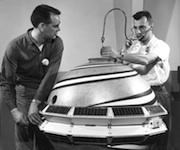Beeping radio signals from Sputnik inspired the idea of using satellites to navigate.
The idea for the first space-based navigation system was born at the Johns Hopkins University’s Applied Physics Laboratory (APL) in 1957, as scientists listened to the radio signals from Sputnik, the world’s first satellite. By 1964, the Navy was using radio signals from its own satellites to navigate submarines and surface ships, a system they named Transit.







